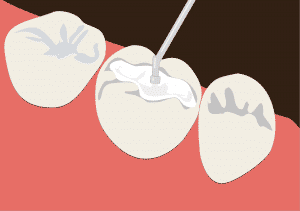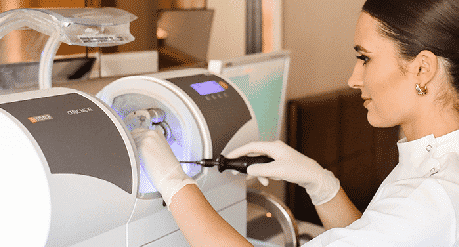Why should I choose porcelain fillings over composite?

Today, with modern technology, we can offer the patient top-quality long-lasting fillings in a matter of one hour. The ever-increasing demand for aesthetic restorations (white fillings), together with increased longevity, has led to great advances in certain dental materials. One of the most common misconceptions we find in dentistry is that many people think all white fillings are the same. This is far from the truth. There are fundamentally two different types of white fillings – resin and porcelain.
We often compare the difference between porcelain fillings and composite fillings like the difference between your plastic picnic plates verses your fine china dinner wear. They’re like chalk and cheese. In terms of terminology, plastic white fillings can be referred to as composite or resin. Porcelain fillings are often called inlays, ceramic or Cerec restorations.
Composite resin fillings do not have the same success rate as porcelain or gold. They cost less but need to be replaced on average every 4 to 5 years as they are unable to withstand heavy chewing pressure and fracture more easily. They also shrink as they are set – the bigger the filling, the more the shrinkage, meaning larger plastic fillings can become “leaky” and allow decay around their margins. They also tend to lose their colour and lustre over time and can look unattractive whereas a Cerec porcelain filling can last up to 15 years and longer.
Porcelain fillings are a lot harder than resin and more natural looking, blending very well with the surrounding tooth structures. Nowadays porcelain fillings are made mostly chair- side, while you wait. The advantage of chair-side manufactured porcelain fillings using “cad cam” technologies – like Cerec restorations – is that they have the same success rate as gold: 93 per cent after 15 years. The wear on porcelain fillings is similar to that on a tooth and with modern bonding techniques, there’s no need to remove a lot of the tooth structure. On molar teeth, which sometimes require a larger filling, they are the material of choice. They are metal free and biocompatible.
In terms of the porcelain filling procedure itself, first of all we do an examination, we take x-rays, we see what needs to be done.
Then we numb the patient up, we remove all the decay and the filling that needs to be replaced.
We then take an infrared camera and take photos of the tooth. So we’ve got an inter-oral camera, which is a 3D camera, and we put it on the tooth and actually take pictures. And you can see the picture’s coming up on the screen, on the Cerec unit, and that basically forms the model. From that model we then actually design your new restoration with the help of a computer. And the nice thing about that is we can actually change and make the filling bigger, make it any shape we want, until we’re happy, until the patient’s happy. Then we actually put in a block of ceramic into the metal unit, and start milling the restoration out of the block so that it comes out exactly the right size. Then we just polish it, make it nice and shiny, glue it in, check the bite, and there you go.


Both types of restorations utilise the same blue light that is used to set hardened cement material. The resin is placed in soft and set hard with the light, whereas the porcelain restoration is a hard prefabricated filling that is bonded into the cavity. When a filling is on the larger side, requiring corners or what are termed as cusp replacements, we always recommend porcelain reconstruction of the tooth to ensure that you are not back in the dental chair fixing the same tooth again any time soon. And for smaller fillings, like smaller cavities in the front of the mouth, we normally use plastic or resin fillings. For removing or replacing of the amalgam fillings, Cerec is probably one of the best choices to use then.
At Smile Solutions both options of white fillings are readily available. It’s a matter of working out with you which option best suits your expectations and budget. The benefits and advantages of having a Cerec porcelain filling as opposed to a normal, white filling is it’s a single visit procedure.
The porcelain filling is no doubt more expensive, costing between $1500 and $2500, compared with composite from $400 to $600. But when you consider you may have to replace a plastic resin filling over and over, the cost differential may prove to be a lot less than first envisaged.
Every time a tooth or filling fractures or is subject to active disease, this creates a potential for catastrophic failure, which can require removal of the tooth. To restore a missing tooth requires either an implant at a cost of $6500 to $8000, depending on bone adequacy; or a bridge ($6500 to $7000); or denture ($1500 to $2500). Therefore, when we dentists recommend a porcelain restoration (either a crown, an inlay or an onlay) we are trying to give you, the patient, the most appropriate long-term solution and hence prevent catastrophic failure, which can be painful, time consuming and costly.
I’m lucky to be with Smile Solutions where we have a very large group of specialists and other Cerec users as well in the practice. We come together once a week to discuss cases and really further our knowledge and share whatever information we’ve got with each other.

